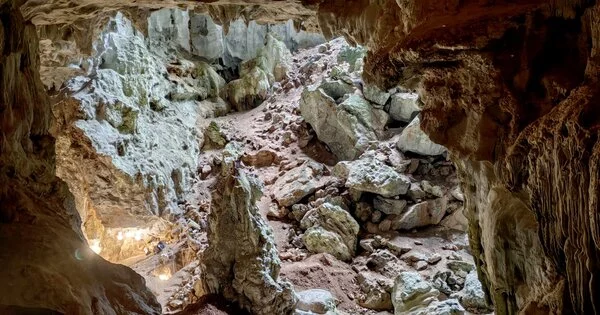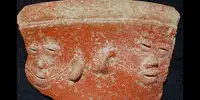Cave excavation projects frequently contribute to our understanding of early human migration and prehistoric cultures. Scientists report in the journal Nature Communications that 15 years of archaeological work in the Tam Pa Ling cave in northeastern Laos has yielded a reliable chronology of early human occupation of the site. Excavations by the team through the layers of sediments and bones that gradually washed into the cave and were left untouched for tens of thousands of years reveal that humans lived in the area for at least 70,000 years – and probably for much longer.
“When we first started excavating the cave, we never expected to find humans in that region,” said anthropology professor Laura Shackelford of the University of Illinois Urbana-Champaign, who co-led the research with Fabrice Demeter of the University of Copenhagen. “However, we discovered our first modern humans during that first season when we began working there.” They were the only early modern human fossils in the region at the time.”
While modern Homo sapiens remains dating back roughly 197,000 years have been discovered in Israel, genetic studies indicate that the main phase of early human migration out of Africa and into Asia occurred much later – around 50,000 years ago, according to Shackelford. Her team’s first excavations in Tam Pa Ling yielded bone fragments from modern human remains dating back approximately 40,000 years. However, as the excavations progressed, the age of the sediments and animal remains discovered alongside the human bones revealed that they were much older.
The entire section of the trench goes from about 30,000 to 80,000 to 100,000 years ago. Flood season after flood season, sediments and bones washed into and deposited in the cave. Since then, they’ve been sitting there.
Laura Shackelford
The team had excavated as far as they could in the cave by 2019, reaching bedrock about 23 feet (7 metres) beneath the surface. Hundreds of animal bones and human skeletal remains were discovered during the excavations. The deepest human bone recovered, a partial tibia, was resting on bedrock near the trench’s bottom. Analyses of sediments taken just above this bone show that the soil was deposited between 67,000 and 90,000 years ago.
“The entire section of the trench goes from about 30,000 to 80,000 to 100,000 years ago,” Shackelford explained. “Flood season after flood season, sediments and bones washed into and deposited in the cave. Since then, they’ve been sitting there.”
The team used several techniques to date the sediments and nonhuman mammal bones discovered at various depths in the cave. For the soil samples, the researchers primarily used an optically stimulated luminescence technique, which reveals how long it has been since sediments were last exposed to light. In complete darkness, numerous soil samples were collected from the cave and returned to the laboratory for analysis.

Other techniques were used by the researchers to date the soils, human and animal bones, and teeth discovered at various depths in the trench. The human remains were fragmentary, but the site yielded two pieces of skull, both from the frontal region of the head, one dating to around 35,000 years ago and the other much older, dating to around 67,000 years ago, according to Shackelford.
The researchers were initially perplexed by a comparison of the physical characteristics of the fossils, according to Shackelford.
“What we saw was that the youngest fossils, the first ones we found, looked old,” she explained. “And the oldest fossils we found at the very bottom appeared to be younger.” It was the polar opposite of what we expected to find because as you go further back in time, you expect things to become more archaic, more like ancestral populations.”
According to Shackelford, there are two possible explanations for the differences between the older and younger fossils. One possibility is that the older fossil came from an ancestral population with more modern characteristics than their descendants, who interbred with people with more archaic features. The two skulls could also represent two distinct migrations into the region, according to another theory.
“We don’t know how they’re related, but we have two very different looking groups of humans,” said Shackelford. “The older fossil was most likely a part of an early migration – a failed migration because it did not give rise to people who are still alive today.”
According to Shackelford, the team was unable to extract viable DNA from the human remains, which is a common problem in studies of ancient remains from tropical sites.
“I believe that genetic data is the only way to answer our questions,” she said. The team is storing the human fossils in a freezer in the hope that improved DNA extraction and analysis techniques will yield more answers one day.
















